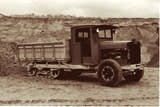Linn Manufacturing's Tractor Truck
In the early days of truck haulage following World War I, the Linn tractor truck was able to keep loads moving in impassible conditions where roads barely existed.
Beginning in 1916, Linn Manufacturing of Morris, N.Y., built a series of heavy-duty haul trucks up to 12 tons capacity designed to overcome the problems of hauling large loads over non-existent roads. The secret of the Linn's success lay in its patented rear-end, crawler-type traction unit. Unlike regular trucks of the day prone to mire with their narrow solid rubber tires, and unlike most rigid crawler designs of the day, the Linn crawler assembly featured a flexible track-roller design. The gear-driven assembly incorporated trunion-mounted track rollers able to follow irregular ground surfaces ensuring positive traction. And with the added advantage of lower ground pressure imposed by the tracks, the Linn was able to pull through adverse conditions which sidelined other vehicles.
The Linn was available in several guises and offered with a variety of power units. A "Contractor's Special" was equipped with an 8-yard rear-dumping body with "Linn automatic down-fold tailgate" and available with six-cylinder Cummins or Waukesha diesel power in the 150-horsepower class. It was equipped with a shuttle-shift transmission providing four speeds in each direction. Four reverse speeds made sense given that in the open-cab version, the driver could make use of an auxiliary seat facing to the rear when moving in reverse. It was a valuable feature for accurately spotting under shovels or for safely moving to the edge of high dumps.
The "County and Township Special" included a spreader-type tailgate and was specially designed for towing road machines such as pull-type graders. Northern loggers favored the "Logging Special" which included an enclosed cab as standard and optional sled runners to replace the front steering axle. Loggers used them to drag logs out of the woods, often making up trains of three or four sleds loaded with logs. The train sometimes included a caboose for crew living quarters when working in remote areas. Other models were customized for levee work with side-dumping body, or came equipped with a special 14-yard body for hauling coal or culm in the coalfields. The Linn also made a rugged and stable carrier for mounting mobile cranes and excavators.
The Linn boasted a top speed of 7.5 mph. This may not seem fast by today's standards, but when you consider the Linn hauled much more per load, and traveled twice as fast as the competitive tractor-drawn dump trailers of the 1920s, the economics made sense. After building a few more unusual vehicles in the 1940s, including one model equipped with rear wheels that could be lowered for use on paved surfaces, the short-lived Linn Manufacturing went out of business in 1950.
You can read more about the evolution of construction equipment in Keith Haddock's latest book release, an updated version of his fully illustrated Earthmover Encyclopedia. Also, consider a membership in the Historical Construction Equipment Association, www.hcea.net.


